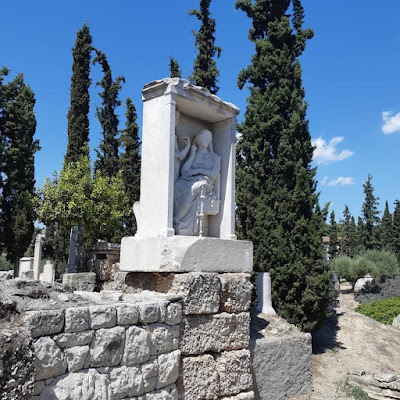Let’s now to turn to my own research. While the great majority of my time has been spent working on the final chapter of my dissertation in which I examine the motivations behind and attitudes towards family limitation methods in a Roman context, I wanted to challenge myself further by learning how to handle a new category of evidence that I found intimidating: enter Greek epigraphy. After reading through some scholarship that discusses family relations and women in Greek epigraphy, I made my way to the collections of the Epigraphic and National Museums and surrounded myself with the material, taking countless photos of stelai that feature depictions of the family and accompanying inscriptions. In October I attended a conference that was held in honour of Dr. L. Threatte, in which renowned scholars discussed various facets of Greek epigraphy, Attic laws and orators, and decrees. It was fascinating to see this category of evidence be examined and interpreted. Also, I must say that engaging with the academic community at the various archaeological schools in Athens has been a stimulating and rewarding experience. The scholars that I have met during my time here thus far (of which there are too many to name!) have been incredibly supportive and generous with their time. It’s a wonderful environment for a young scholar to develop her ideas.
Lastly, a quick word on an adventure that I took outside of Athens. In November I was given the opportunity to take a trip to Crete and I jumped at the chance. Crete is such a unique island that feels like a completely different world and one that is difficult to describe. The archaeologist in charge of the trip was Dr. T. Brogan, who led the group around the different sites on the island and introduced us to the important work done by the Institute for Aegean Prehistory (INSTAP). There were two sites in particular that were incredibly striking. The first site was Lato, a Dorian city-state, which has to be one of the most beautiful places I have ever seen, complete with breathtaking views that I will never forget. The second site was Gortyn, the home of the queen of all Greek inscriptions: the Gortyn Law Code, which is an extraordinary document that sheds light on important aspects of daily life on Crete. Providing content ranging from intermarriage between slaves and free persons and the exposure of children, to the liability of heirs and the ransom of prisoners, this inscription is a dream for social historians. I was able to see the great code up close and witness the boustrophedon first hand. Finally, the food on the island was absolutely amazing and I have to say that some of the best meals that I’ve had in Greece have been on Crete!
I cannot wait to see what the second half of my year in Athens has in store!
Barbara N. Scarfo
Homer and Dorothy Thompson Fellow, CIG





No comments:
Post a Comment